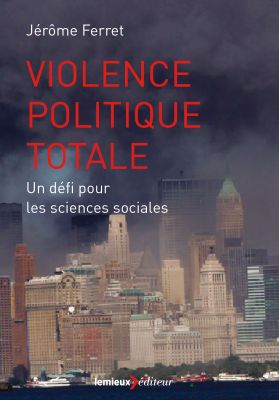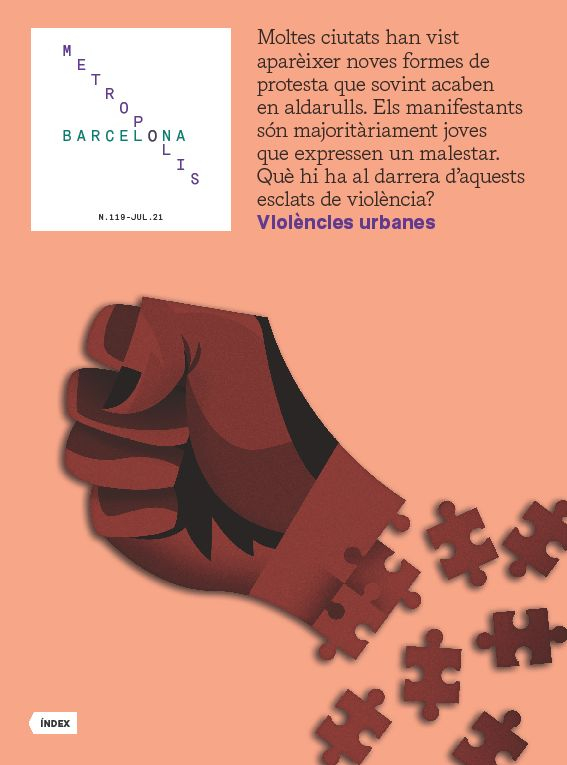The new social violence
- Dossier
- Sep 21
- 12 mins

The social sciences often associate the violence that is manifested on the street with an organisation, a social movement or an ideology. The new forms of protest are more difficult to decode. Uncertainty as to their origin should not lead us to think that this violence is blind, that it does not make sense. The foundations on which it is built seem to be unknown, but they stand at the crossroads of a series of far-reaching social and cultural changes.
Interpreting violence – increasingly mediatised by the mainstream press and now too, and fiercely so, by social networks – always implies a risk. Sometimes it is afforded too much importance and too many meanings. Other times, however, it is considered, all too easily, gratuitous, destructive and a sign of the “ravaging” of our societies. In both cases, the mistake is the same: neglecting to perform an analysis of violence as such, letting it “cool down”, as they say in sociology. Associating it with the social and political spheres is always forgotten. And so, today the situation is enormously complicated, since, we evidently lack a model of interpretation that adapts to our “modern social condition”, coming back to a term used by Martuccelli. To endeavour to fill this gap, in our work theorising the transformations of violence in Spain and, more generally, in European societies, we have advocated for the development of a new comparative paradigm (based on the work of Touraine, Wieviorka, Pérez-Agote and Tejerina). This study, published in 2016, partly based on the sociology of knowledge (mediatisation and the interpretation of violence on the street are, in themselves, a highly political challenge), should allow us to analyse contemporary social movements and the links that associate them with violence, economic changes and forms of communication.
Movements such as the revolts in the French ghettos, which emerged as a result of police violence, and also, more recently, that of the Yellow Vests in France,[1] that no sociologist or politician could see coming, more than testify to the need to overhaul the interpretation of social movements and violence. In the case of Spain, mention can be made of the incidents of violence that have erupted on the streets of Barcelona, including mobilisations in September 2010 and, very recently, protests over the Pablo Hasél case, in February 2021, perpetrated by self-described “anti-system” protesters, without really knowing what is behind this name.[2]
Due to the series of violence labelled, too imprecisely, as “urban”, it is fair to wonder how the current rebellious violence in European societies should be defined when it assumes such different forms and, above all, is so distorted by the media and populist discourses. What we intend to point out here is simply the fundamental ambiguity of the relationship between violence and movements, in the sense that these movements are violent or, by all means, interpreted as such. The new characteristics of these movements are disconcerting: they are sudden, expressive, ultra-mediatised in a viral manner (such expressive violence has its audience on the Internet), they trigger hyper-anxiety, and are subject to constant overinterpretation.
Clearly, the new configuration of violence raises questions for anyone who tries to understand it: is the violence expressed in this configuration always relational? In other words, is it always a function of the relationship between well-identified actors (militants with a clear political plan) who have clear political goals and meanings, as has happened until now? The truth is that it is not very likely, and to affirm it this way is such a categorical hypothesis that it breaks with a collective unconsciousness, prevailing especially in the social sciences, which has always endeavoured to relate the violence that is manifested on the street with an organisation, a social movement or an ideology. The current situation is much more difficult to decipher, since, on the one hand, there are long-standing social movements with a very marked ideology that are fighting not to disappear (such as Spain’s pro-independence movements) and movements with no ideology, disorganised a priori, that try new forms of structuring, especially through the digital world, and that can both fight against society and challenge from within the social order as it tries to impose itself.
[1] 2018-2019; more than three million protesters are estimated to have taken part in the iconic incident of violence, the looting of the Arc de Triomphe in Paris, on 1 December 2018.
[2] Jordi Mir, “Hablemos de violencias” [Let’s Talk about Violence], in El País, 7 March 2021.
Today violence is more ambivalent, so it is difficult to discern which political category it belongs to. It can be a struggle with identity, national or religious objectives or, simply, may not have any apparent objective.
A new type of relationship between violence, movements and politics
Let us take the case of Spain, a country shaped by powerful longstanding nationalisms and that is now shaken, like other societies, by new cultural and identity challenges (historical memory, religion, gender, race) and by the harsh deterioration of the fundamental economic and social conditions of young people in particular and of wage earners in general. This chronic uncertainty, which grips people’s lives and futures, has been radicalised by the omnipresent experience of the current pandemic, which speeds up the activity of social breakdown. This configuration generates an unprecedented social violence and automatically engenders expressions of violence that no longer correspond to the classic frameworks of demanding and orchestrated politics characteristic of industrial societies. Today violence is more ambivalent, so it is difficult to discern which political category it belongs to. It can be a struggle with identity, national or religious objectives or, simply, may not have any apparent objective, without this implying that it does not have the capacity to constitute itself in a social movement and to structure violence beyond mere rage. However, uncertainty as to its origin should not lead us to think that this violence is blind, that it does not make sense. Although the foundations on which it is built seem unknown, it is still true that it is situated at the crossroads of the series of far-reaching social and cultural changes that arise in European societies.
When we studied the kale borroka [‘street fighting’, urban guerrilla actions carried out by Basque nationalist youth] in the Basque Country during the years 1990-2000, we could already see its transformation, which earned us a great deal of criticism from those who saw ETA behind all the acts of insurrection on the street.[1] We, on the other hand, observed that identity, nationalist and radical violence could re-emerge once a powerful social movement that ensured its historical adherence disappeared. Thus, we show that, from the late 1980s, the kale borroka fed on other activisms that stemmed from the new globalised social issue, but that were not necessarily nationalist.[2]
Let us now take the example of France. Recently, the sociologist Sommier developed an unpublished database comprising 6,000 incidents of political violence that occurred from 1986 to the present day, which he classified according to the cause they defended: ideological, pro-independence, religious, professional and social. Without playing down the drama of the terrorist attacks in Paris in 2015 or the seditious riots in recent years, the classification puts the idea of the increase in political violence in France into context, where today the number of attacks on people is much lower than the attacks on material goods. Thus, it confirms a decline in pro-independence violence, but at the same time reveals the diversity of expressions of anger against representative democracy that is on the rise and against an increasingly aggressive world of work that is losing meaning. The lesson that can be drawn is clear: the intensity with which the old social movements fought for social integration in class-structured societies is the same with which today the new sudden and fragmented movements fight against social breakdown in a society in which an attempt is made to reinvent the ties of solidarity, an undertaking that sometimes experiences violence and confrontation.
[1] The kale borroka has become a stereotype used to condemn any street violence. Recently, the leader of Vox [a far-right political party in Spain], Santiago Abascal, accused the Barcelona protesters of being “organised gangs of street terrorism”.
[2] “El giro social de la ‘kale borroka’” [The Social Turnaround of the “kale borroka”], in El País, 31 March 2012.
 © Nicolás Aznárez
© Nicolás AznárezThe old social movements fought for social integration in class-structured societies; today, the new sudden and fragmented movements fight against social breakdown.
New properties: the paradigm of the Yellow Vests
Whoever follows social movements and their association with violence over a long period will surely be surprised by the spontaneity that characterises “street movements” today, at least since the late 2000s. They will also see a major change that hinders the analysis and the work of institutions such as overwhelmed police forces. The latter also produce violence and also see how their legitimacy is questioned. Let’s take an example of this turning point that we believe is significant: France’s Yellow Vests movement in 2018-2019. This movement came about from a group Facebook account created in the south of France. A small group of artisans and businesspeople rallied against the rise in the price of diesel and advocating the recognition of the Citizens’ Initiative Referendum. The initial group progressively expanded to become a movement broad enough to mobilise very diverse social sectors: secondary school students, university students, businesspeople, artisans, care workers, retirees... In short, a series of people who practised undervalued professions took advantage of the digital world to rally together, despite having very different social backgrounds and ages.
The movement therefore emerged from affinity groups built on social networks outside the radars of public opinion polls. It manifested a deep sense of anti-institutionalism and invested particularly important capital: the visibility of outsiders, and even of the marginalised, on the social scene. Most of the latter had very little experience in demonstrations and clashes with the police during mass demonstrations, which explains the excesses and the unprecedented rise in violence.
These apparently disordered social reactions are also the expression of a new social class in the making: individuals excluded from within.
But the interpretation of a social movement of these characteristics does not have to be reduced to the expression of social outrage and a series of outbreaks of violence. In fact, it is a new form of violence that was already brewing in our tired democracies as of the early 1990s. In France, today, but it could also be demonstrated in the case of Spain (following the liberalisation of universities in the late 2000s) that the social issue has vigorously returned to the political arena, as Pierre Bourdieu already demonstrated in La Misère du monde [The Weight of the World], in 1993, around the “social fracture”, a result of the neoliberalisation of welfare states. The works of Serge Paugam also showed that these apparently disordered social reactions are also the expression of a new social class in the making: individuals excluded from within. First of all, excluded from the world of work: perhaps because of a lack of jobs, and now also because of having a job but not being able to get by on it or because of having a well-paid but unsatisfying job. In principle, work was the core factor in defining personal identity, from a material dimension and in turn, and above all, an extremely strong affective dimension. The fact is that the youngest members of society, and also the elderly, including executives, experience a material and symbolic decline caused by a loss of meaning and marginalisation, particularly in care work and teaching. And, secondly, excluded from the political world, since electoral processes tire voters, young people vote less and less, abstain and today condemn the large number of democratic drills, some real and others imaginary; meanwhile, the proliferation of corruption cases within the Spanish royal family fosters the feeling, already expressed by the “indignados” [the outraged movement in Spain], that the Spanish political transition is an institutional hypocrisy.
 © Nicolás Aznárez
© Nicolás AznárezThe expression of violence is never gratuitous. It can be considered a disease or pure vandalism. But not wanting to make sense of it does not mean that it does not have one.
All these professional and political ties were admittedly based on different morals, ethics and conceptions, but they guaranteed equal integration or, at least, a common belief. In today’s social reality, more and more individuals perceive integration as fundamentally unfair. And this sensation, objective or subjective, is confirmed by sociological analyses: today the social world is very fractured. Thus, a distinction can be made between those who have guaranteed integration thanks to an elitist schooling and the accumulation of advantages; those who – the vast majority – have a weakened integration (individuals more exposed to risk who feel a lack of recognition and an agonising “breakdown”); those who have precarious integration, the precariat; and those with clearly marginalised integration, the working poor. The last three groups have common experiences, share them, and can meet at some point in time to express their anger, either on the Internet or directly on the street.
Violence and the “non-social class”: rebuilding the link
In the case of the Yellow Vests, but also in that of many other mobilisations of the “indignados”, the fragile, the precariat and the marginalised, they gather together, make themselves visible and build mutual recognition, a way of reducing the tension between the objective of guaranteed integration and the threat of marginalised integration, which explains the coming together of the middle classes and the university intellectual classes, threatened by poverty. They were invisible and are becoming visible, although for some it involves the use of violence, either due to the desire to shock or due to inexperience and social fatigue accelerated by COVID-19.
Therefore, this violence is nothing but the symptom of a deep sociological rupture that explains the spread of this outrage that can sometimes end in violence: it is the constitution and expression of a “non-social class” that turns the collective representation of society upside down, previously structured in stable and integrated social classes.
So the expression of violence is never gratuitous. Admittedly, it can be difficult to fit it into the language of the past, for example, through the social movement in its highest degree of historical consciousness, such as the workers’ movement; it can be considered a disease, and we may want to criminalise it by calling it pure vandalism. But not wanting to make sense of it does not mean that it does not have one. In our view, what lies behind is always deeper than a series of moods; what lies behind is the link between individuals and society. And it is quite dramatic, but also reassuring, to see what Émile Durkheim, the founder of sociology, told us 120 years ago, when he spoke of anomie as a weakening of our belief in the institutions.
References
Bourdieu, P. (dir.). La misère du monde. Seuil, Paris, 1993.
Ferret, J. Crisis social, movimientos y sociedad en España hoy. Ensayo sobre el proceso Conflicto, Violencia y Subjetivación. Sibirana, Saragossa, 2016.
Martuccelli, D. La condition sociale moderne. Gallimard, Paris, 2017.
Pérez Agote, A. Las raíces sociales del nacionalismo vasco. CIS [Spanish Centre for Sociological Research], Madrid, 2008.
Paugam, S. (dir.). 50 questions de sociologie. PUF, Paris, 2020.
Paugam, S. 33. “Comment comprendre le mouvement des Gilets Jaunes?”, in Paugam, S. (dir.). 50 questions de sociologie. PUF, Paris, 2020.
Sommier, I. Violences politiques en France. Presses ScPo, Paris, 2021.
Tejerina, B. La sociedad imaginada. Trotta, Madrid, 2010.
Touraine, A. Production de la société. Seuil, Paris, 1973, 1993.
Wieviorka, M. “Le nouveau paradigme de la violence (parts 1, 2 et 3)”, Cultures & Conflits, 29-30, [online]. 1998. Published online on 16 March 2006. URL: http://conflits.revues.org/index724.html.
Wieviorka, M. La violence. Hachette, Paris, 2005.
Recommended publications
 Violence politique totale. Un défi pour les sciences socialesParís: Lemieux Editeur, 2015
Violence politique totale. Un défi pour les sciences socialesParís: Lemieux Editeur, 2015 Crisis social, movimientos y sociedad en España hoy. Ensayo sobre el proceso conflicto, violencia y subjetivación. Zaragoza: Sibirana, 2016
Crisis social, movimientos y sociedad en España hoy. Ensayo sobre el proceso conflicto, violencia y subjetivación. Zaragoza: Sibirana, 2016
The newsletter
Subscribe to our newsletter to keep up to date with Barcelona Metròpolis' new developments




